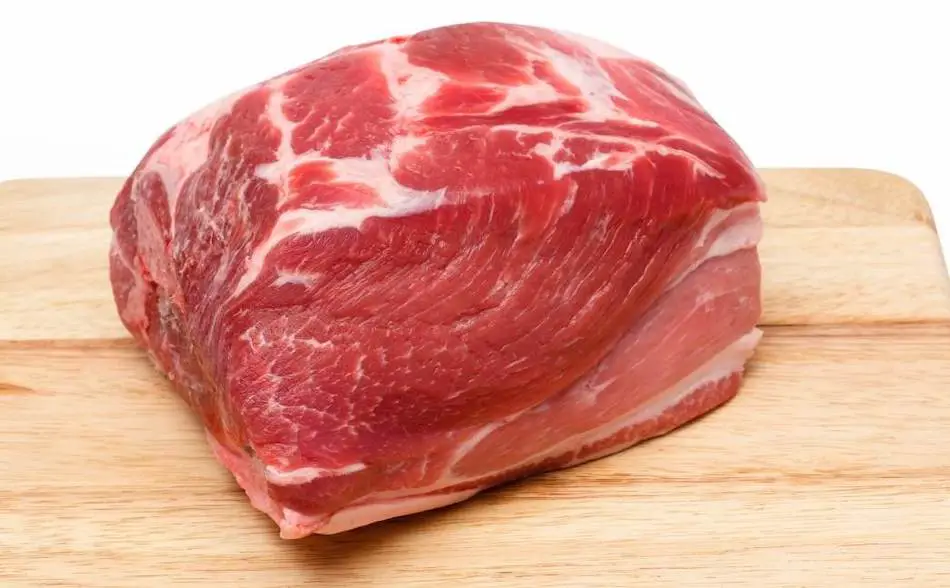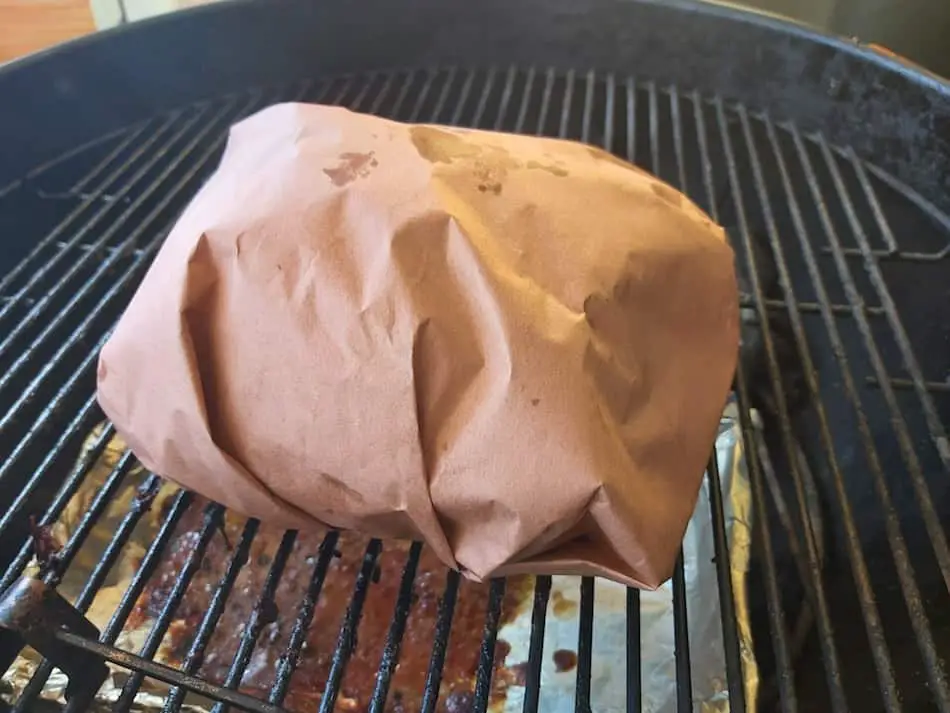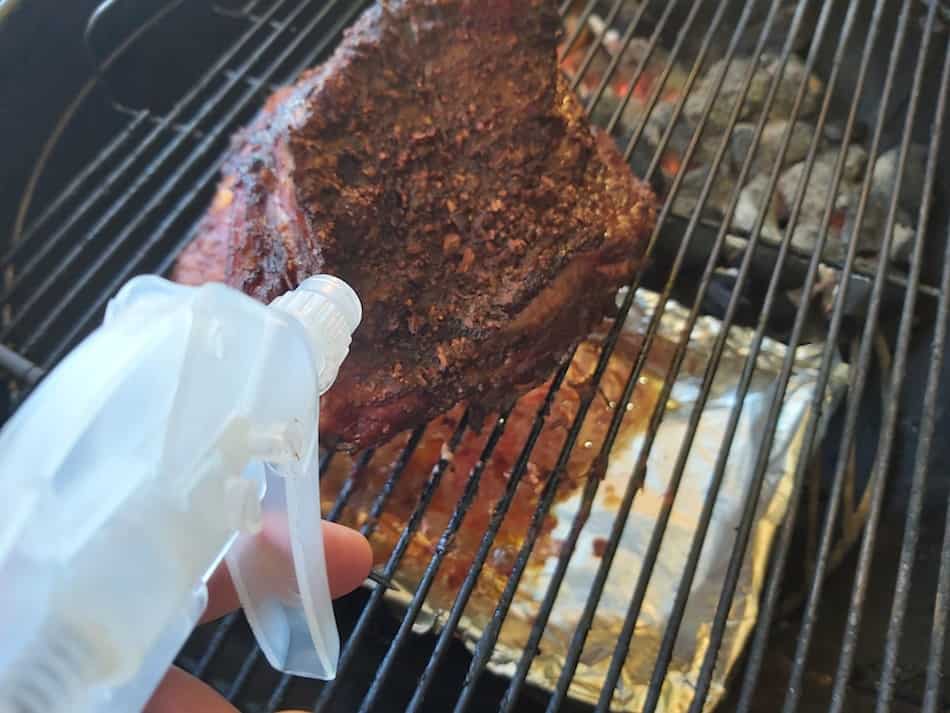
As with all low and slow cooking, temperature will make or break your pork butt. I wanted to know how some of the world’s best pitmasters smoke pork butt, so I did some research to find the ideal cooking temperatures and techniques.
The standard temperature for smoking pork butt is between 225°F and 250°F, however, you can go as high as 275°F. At these temperatures, the pork butt will take between 1 to 1.5 hours per pound. The cooking temperature depends on the size of the meat, and the average pork butt weights between 6 to 10 pounds.
| Temperature | Result |
|---|---|
| Less than 225°F | Meat may be in the “Danger Zone” for microbial growth, may not be tender and juicy |
| 225°F | Tender, juicy pork with plenty of smoke flavor |
| More than 225°F | Moisture may escape, resulting in dry pork |
Key Points
- The standard temperature for low and slow cooking pork butt is 225°F
- This temperature keeps the meat out of the “Danger Zone” for microbial growth and allows it to cook slowly, breaking down fat and connective tissue for tender, juicy meat
- Cooking at 225°F also allows the pork to absorb more smoke flavor
- Cooking at higher temperatures can cause moisture to escape and result in dry pork, while cooking at 225°F ensures tender, juicy meat
- The collagen in pork shoulder needs long cooking times at low temperatures to break down, resulting in a tender, flavorful pork butt.
Different Temperatures To Smoke Pork Butt
Pork Butt at 225°F. The standard temperature for low and slow cooking is 225°F. You don’t want to go any lower than this temperature because it will place the meat close to what the USDA calls the “Danger Zone” for microbial growth. At 220°F, the meat is safe to sit on the grill and cook all day and night, slowly breaking down all the fat and connective tissue in the meat, resulting in tender, juicy pork.
225°F Equals More Smoke. The low 225°F temperature will also ensure the pork butt will have plenty of time to absorb smoke. If you were to cook at a higher temperature, the meat would spend less time in the smoker and therefore have less smoke flavor.
Moist Pork Guaranteed @ 225°F. The problem when cooking at higher temperatures is moisture will escape, causing dry pork.The benefit of a 225°F pork butt is it will be tender and juicy.
Tender Pork Guaranteed @ 225°F. Pork shoulder contains a lot of collagen, so if we cook it too fast, it will be chewy. The collagen needs hours upon hours at a low temperature in order to break down. The result of rendered collagen is a delicious gelatin like texture with unbelievable flavor!
Pork Butt at 225°F – How Long Will It Take? I’ve heard all kinds of time frames for smoking pork butt at 225°F. The most accurate I’ve found is 1.5 hours per pound. Obviously, the total cook time will depend on the size of the meat, but other techniques such as wrapping and spritzing will also come into play.
Pork butts vary in size, but you will find they weigh between 6 to 10 pounds. A pork butt weighing 6 pounds will probably take around 8 to 9 hours at 225°F. A larger 10 pound pork butt at 225°F can take anywhere between 12 to 15 hours. For a more on this, check out : How Long Does It Take To Smoke Pork Butt? We Break It Down For You.
Cooking Overnight At 225°F
If you have a pellet grill or an electric smoker, 225°F is a good temperature to cook your pork butt overnight. Pellet grills and electric smokers produce less smoke than charcoal or wood smokers, so the low 225F temperature is a way to expose the meat to smoke for a longer period. I’m not a fan of overnight cooks, mainly because I don’t like leaving any of my smokers unattended. However, if you have a safe setup, leaving your pork butt overnight at 225°F is a good option. For more information on this subject, check out this article: The Overnight Cook-Finishing In The Oven.
Wrapping – Speed Up The Cook
Wrapping the pork butt in the second half of the cook can take an hour off the cooking time. When you wrap the pork in foil, heat gets trapped inside the foil package and the meat will begin to almost steam. An unwrapped pork butt will take much longer to cook, and may get stuck in the stall for hours. The other problem with an unwrapped pork butt is it may become over-smoked, which will make the meat taste bitter. You also might be interested in this article: Paper vs Foil- Which Wrap Is Best?

Have you seen the most advanced thermometer on the market? FireBoard can be controlled via your phone, holds meat 6 probes, and records your cook data on a cloud.
Pork Butt at 250°F
If you want to save yourself time, 250°F is a good temperature to smoke your pork butt. A 250°F will cook the butt a little faster without placing the pork at risk of drying out. This temperature will still give the pork enough time to sit in the smoke.An average-sized 6 to 7 pound pork butt cooked at 250°F will probably take about 7 – 8 hours thereabouts.
Pork Butt at 275°F
I’ve seen barbecue guru Aaron Franklin knock out a Texas style pork butt at 275°F. Franklin seems to cook most of his meat in this range, and it’s still considered low and slow. You can definitely try this temperature but make sure it’s good quality meat. Be careful watching YouTube cooks because often the pitmasters are using high-quality meat with high marbling. The meat grade makes a significant difference in the final product. High-quality meat cooked at a higher temperature will hold up better than lower meat grades.
Pork Butt At 275°F – How Long Will It Take?
A Pork butt cooked at 275°F should take just over an hour per pound. So an 8 pound butt should take around 8 to 9 hours. Obviously, this is just an estimate and you need to factor in other variables. A 275°F will pork butt is a great option if you’re short on time.
Hot and Fast Pork Butt – 300°F Plus!
You’ve probably heard of hot and fast briskets, but what about pork butts cooked above 300°F? A hot and fast pork butt will be cooked in no time at all, however, the meat will not be as tender and juicy as a slow cooked butt.
The connective tissue in pork shoulders needs time at low temperatures in order to break down. When cooked at temps above 300°F, the connective tissue doesn’t get enough time to render. So the tradeoff with hot and fast is a drop in quality. The difference is noticeable when taste tested, but if you need some pulled pork in a hurry, don’t be afraid to crank the temperature of your smoker.
As with all hot-and-fast cooking, give the pork butt every chance by practising the fundamentals. Wrap, spritz, brine and inject to help the pork butt survive the higher temperature. You should rest the meat well if you have cooked hot and fast. If you don’t rest the meat, it will dry out. If you want to lear how to cook pork butt faster, check out this article: Hot And Fast Pork Butt For Pulled Pork.
World Brisket Champion Harry Soo is now sharing his secrets with his Competition Meat Rubs.
When To Wrap?
Wrap the pork butt once the internal meat temperature reaches 165°F. By this stage, the bark should be set, and you can test this by touching the outer crust.
Some pitmasters add a few sticks of butter and sprinkle brown sugar on the pork before wrapping. You can also pour in some apple juice or barbecue sauce at this point. The extra moisture will benefit the pork and add extra flavor.
Wrapping is an essential step when smoking pork butt. Foiling the butt has several benefits. First, foil will protect the meat from being over-exposed to smoke; second, wrapping will speed up the cook and help push the meat through the stall. Wrapping will also keep the meat moist. For more on wrapping, you might be interested in this article: When To Wrap Pork Butt – Timing Is Everything.
Spritzing
It’s important to spritz the pork butt at the right time. You want to leave to pork butt alone for the first 4 to 5 hours and give the bark a chance to set. Begin spritzing the butt after the rub no longer sticks to your finger when you touch the pork. This should occur around 4 hours into the cook. Once the meat has reached this stage, begin spritzing every 30 to 40 minutes until you teach the wrapping stage. Check out another article on this subject: How Often Should You Spritz Pork Butt?

Resting
Along with temperature control, resting is one of the most important steps of the cooking process if you want tender, juicy meat. Resting will allow the butt time to reabsorb moisture that would be lost if you sliced too soon.
If you are cooking the pork butt at one of the higher temperatures, then resting is especially important. A hot and fast cook will put the pork at risk of drying out, so the meat will need all the help it can get. Read my full length article on this subject: Rest Pork Butt How Long?
Prepare Your Butt For Best Results
When preparing your pork butt, consider brining or injecting the meat prior to smoking, especially if you are cooking at one of the higher temperatures. A dry brine is as simple as rubbing kosher salt into the meat. The salt will help the pork butt retain moisture if you are cooking at a high temperature for a long period. Injecting is another high-level technique used by pitmasters in barbeque competitions. Pumping the butt with a brine, broth or marinade is a guaranteed way to ensure the flavor and moisture gets deep inside the meat and won’t dry out during a hot and fast cook. Inject Pork Butt – The Complete Guide To Injecting Pork.
How To Avoid Dry Pork
Dry pulled pork is something you want to avoid at all costs. There are several things you can do to prevent this from happening. Wrapping the meat, spritzing, brining, injecting are useful techniques that will help the meat remain moist. However, temperature control is the most important factor, so too is meat selection. If you buy a lean pork butt, there’s a good chance it will dry out since there is less moisture to keep the meat moist. Resting also plays an important part. If you slice or shed the pork too soon, moisture will be lost. You might also be interested in this article: Why Is My Smoked Pork Dry? Here’s 8 Reasons.
The Best Thermometers To Monitor Temperature
In order to monitor the temperature of your smoker and grill, you need to have decent thermometers.Be sure your thermometers are accurate. Never trust an in- built thermometer, no matter how expensive the smoker. The in- built thermometers on smokers and grills have a terrible reputation for being inaccurate. Check the thermometer by performing an ice bath test or a boiling water test. The thermometer on my pellet grill is about 50 degrees out! If a thermometer is inaccurate, then what’s the point?
When smoking meat, you want a thermometer with two probes so you can measure the temperature of your smoker and the internal meat temperature with the other probe. This is done by clipping a probe to the grill and inserting the other probe into the meat.
Thermometers allow you to make relevant adjustments to the smoker, such as opening or closing off the vents. Most thermometers have alarms that will alert you if the meat has reached a certain temperature of if the cooker is exceeding or dipping below the target temperature.
It is for this reason, experienced pitmasters will tell you to buy your own thermometers. If you want to take your barbecue to the next-level, then you need the right tools. You don’t have to spend a lot of money, you can get an accurate thermometer for $50.
ThermoPro is a company with a solid reputation and they sell thermometers at a more affordable price. My first thermometer was the TP20 , ThermoPro’s best-selling thermometer, and is an Amazon best seller. The TP20 is accurate, has two probes and is very affordable, selling for around $50 (check latest price here).
Wi-Fi Thermometers To Measure Temperature
Thermometers are constantly changing, and we have seen a merging of technology and barbecue in recent years. Many thermometers nowadays are Wi-Fi operated and controlled by an app. The great thing about these thermometers is you can monitor your smoker and meat from anywhere in the world via an app.
Did you know there’s now a meat thermometer with no wires that can control with your phone? Check out MEATER
My Favorite Meat Smoking Tools
Thanks for checking out this article. I hope you learned a few things. Here are some of my favorite tools I use when smoking brisket that may be useful to you. These are affiliate links, so if you decide to purchase any of these products, I’ll earn a commission. But in all honesty, these are the tools I recommend to my family and friends who are just starting out.
Meat Thermometer: There are dozens of fancy thermometers on the market, but I still use my trusty TP20. For around $50, I have a high-quality meat thermometer with two probes, and can track the temperature of my smoker with one probe, and my meat with the other probe. The ThermoPro TP20 is an Amazon Best Seller because it’s the easiest thermometer to operate, is durable, highly accurate, and comes with pre-programmed meat settings.
Instant Read Thermometer: Arguably, the second most important tool you need is a fast and accurate instant-read thermometer. These tools play an important role in the latter stages of the cook when the meat needs regular checking in multiple areas. I use the ThermoPro TP19 because it can do everything a ThermaPen can do, but for a fraction of the cost. You can check out the TP19 on Amazon here.
Wireless Thermometer: The latest thermometers on the market have no wires and can be controlled by wi-fi via your phone. Airprobe 3 is the best of this technology.
Butcher Paper: Wrapping brisket in butcher paper has become a huge trend in barbeque thanks to Aaron Franklin. Wrapping your brisket in paper will give you a nice brisket bark. However, you can’t just use any old paper, it has to be unwaxed, food grade paper. You can find it on Amazon here.
Advanced Thermometer and Automatic Temperature Controller: Once you’re ready to take things seriously, the FireBoard 2 Drive is a six-channel Bluetooth/Wi-Fi thermometer that can monitor up to 6 pieces of meat, control and graph your cook sessions on your smartphone, and attaches to an an automatic blower that will convert your charcoal smoker to a set-and-forget. This is one of the most advanced meat thermometers on the market. You can check it out on the FireBoard website here.
